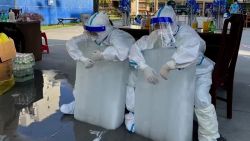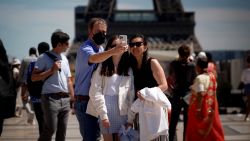A version of this story appeared in the May 28 edition of CNN’s Coronavirus: Fact vs. Fiction newsletter. Sign up here to receive the need-to-know headlines every weekday.
In less than four months, the novel coronavirus has killed more than 100,000 Americans — more than in Vietnam, the Iraq War and the War in Afghanistan combined.
It is a story of lost mothers, fathers, grandparents, siblings, spouses and even children. An even bigger tragedy: They didn’t all have to die.
We now know that weeks of denial, obfuscation and dithering worsened the toll. If the US had started social distancing measures just seven days sooner, an estimated 36,000 lives would have been saved, according to a Columbia University study released last week.
The daily number of deaths has come down from its peak of 2,000 in April, but around 1,400 Americans have been added to those sobering statistics every 24 hours this month.
And even as the slowdown in deaths has encouraged states to restart their economies after more than two months of lockdowns, the crisis is far from over, Stephen Collinson writes.
Coronavirus will surge again when summer ends; infectious disease experts are almost certain of that. They just don’t know how severe the “second peak” will be.
YOU ASKED. WE ANSWERED
Q: What would a “second peak” of coronavirus look like?
A: While we’re still living through the first wave of the pandemic, and cases are still rising, infections could jump up suddenly and significantly “at any time.” That’s how we might get a “second peak,” according to the World Health Organization. A second peak — as opposed to a more gradual second wave — would mean a sudden spike in cases, which could overburden health care systems again and possibly cause a greater number of deaths, many of them preventable. And a second peak could be worse than the first, especially if it arrives during the fall or late winter to coincide with flu season, as predicted. Here’s a look at why it’s inevitable — and what we can do to dampen it.
Send your questions here. Are you a health care worker fighting Covid-19? Message us on WhatsApp about the challenges you’re facing: +1 347-322-0415.
WHAT’S IMPORTANT TODAY
We remember those who died
An army veteran who took pride in his Ford convertible. The first majorette to march in front of the school band. A career nurse. A family man. A grandma who loved playing slots at the casino. A mother who could break out a mean tango. A devoted partner who spent his spare time plotting surprises. A football coach. A tough single mom and councilwoman. A bass player in a rock band called Precious Bones. A fan who never missed a Phillies game. A porter for an Upper East Side apartment building. An immigrant who epitomized the American dream.
More than 100 families share their favorite memories of those they’ve lost — twin brothers, friends, aunts. If you have someone you’d like to honor, please submit their story. You can also share photos, videos, handwritten notes and original artwork by direct messaging us on Instagram, @CNN.

A timeline of the US outbreak
In a matter of months, the coronavirus crisis has exploded into a pandemic of historic proportions. Like a wave, the numbers of those sickened and killed by the virus have swelled in quick succession, leaving many bereft, isolated and wondering: “How did we get here?”
A timeline of this grim reality reveals a country trying to come to terms with the crisis while the death toll continues to rise.
What Bolsonaro said as Brazil’s coronavirus cases climbed
As Covid-19 raced across Europe, knocked the UK Prime Minister flat, and throttled New York City earlier this year, Brazil had plenty of notice that a catastrophe was on its way. But was some of the danger drowned out by the megaphone of its bombastic President Jair Bolsonaro, who has repeatedly dismissed the virus as a “little flu”?
The country now has the second-highest number of cases globally — after the US — recording more than 1,000 deaths and 20,000 new infections yesterday alone.
Test and trace system starts in England
England is launching a “test and trace” system to track coronavirus as lockdown restrictions ease. Under the new system, people who come into close contact with a Covid-positive patient will be told to self-isolate for 14 days.
The program is being rolled out against the backdrop of a mounting scandal over the British government’s coronavirus response. A junior government minister has resigned over the controversy surrounding Prime Minister Boris Johnson’s chief adviser, who breached lockdown. Johnson, who refused to sack his adviser over the unsanctioned travel, has seen his poll numbers drop sharply in recent days.
Russia’s medical workers risk their lives with little applause
Frontline medical workers in the US, the UK and elsewhere may face major risks in their efforts to battle the coronavirus pandemic, but they’ve also seen an outpouring of public appreciation. In Russia, health workers say they face fear, mistrust — and even open hostility.
ON OUR RADAR
- The NBA is working on a plan that would allow players’ family members to stay with them in a so-called “bubble” when the season resumes.
- Disney World is set to reopen – but is it safe to return to the “most magical place on Earth”?
- Autopsies of 10 African-American coronavirus victims show their lungs were clogged with blood clots, according to new research.
- Moms are more likely than dads to have quit or lost their job in the UK, or been furloughed, since the start of the country’s lockdown, according to a new report.
- UK-based budget airline easyJet has announced plans to reduce the size of its workforce by up to 30% as it tries to cut costs in response to the coronavirus pandemic.
- Spain held a moment of silence yesterday to honor those who died of the coronavirus. The silent tribute marked the start of the longest period of mourning in the nation’s history.
- Another sport is back in action. Australia’s National Rugby League resumes today after a two-month hiatus.
TOP TIPS
Public health officials have called on people to stay six feet apart to slow the spread of the coronavirus through so-called respiratory droplets. But experts are warning that six feet may not be enough under many indoor conditions, where the virus can remain in the air for hours and accumulate over time. While more research is needed, they say people need to mask up and take airborne transmission of the virus seriously. The risk of Covid-19 isn’t one dimensional, so keep these factors in mind: distance to other people, environment, activity, and time spent together.
TODAY’S PODCAST
“You can be fairly certain that any food that is served hot will not be a vector for the virus to get to you.” — Neuroscientist Daphna Shohamy
Did you know that you can now bring 12 ounces of hand sanitizer through airport security? CNN Chief Medical Correspondent Dr. Sanjay Gupta offers tips on how to mitigate your risk of infection while flying. Listen Now.




















